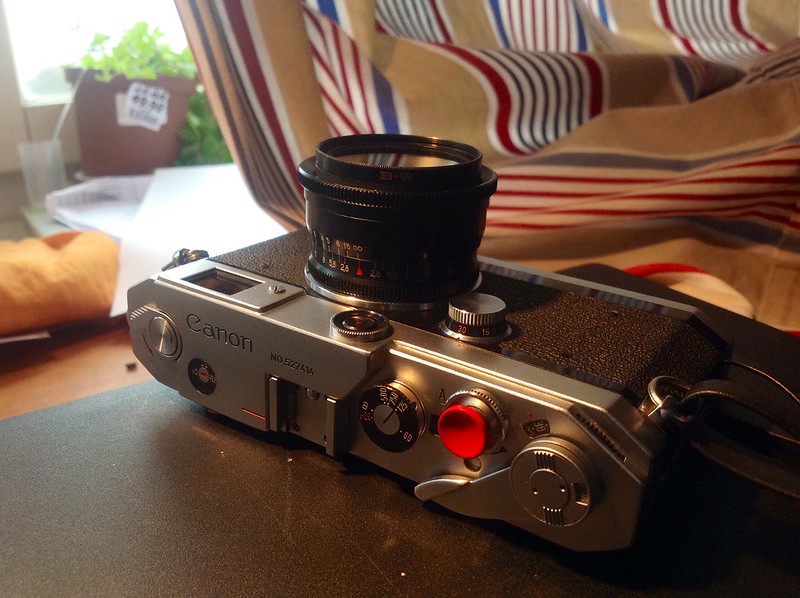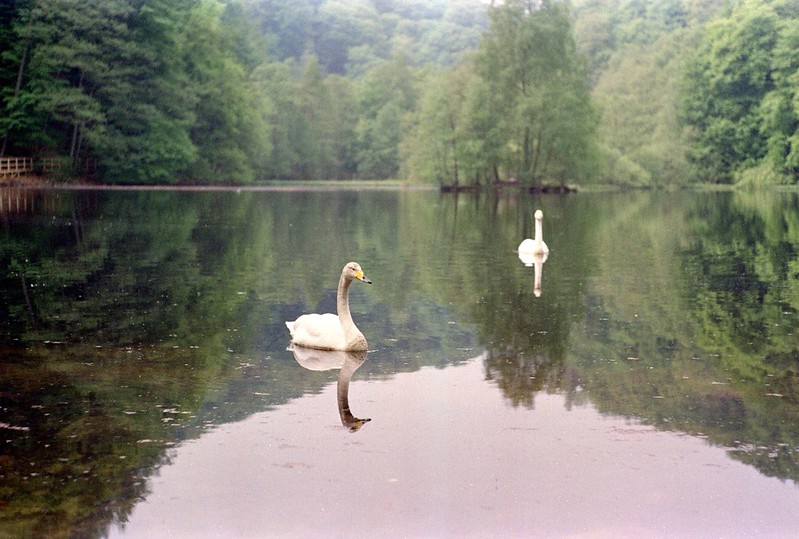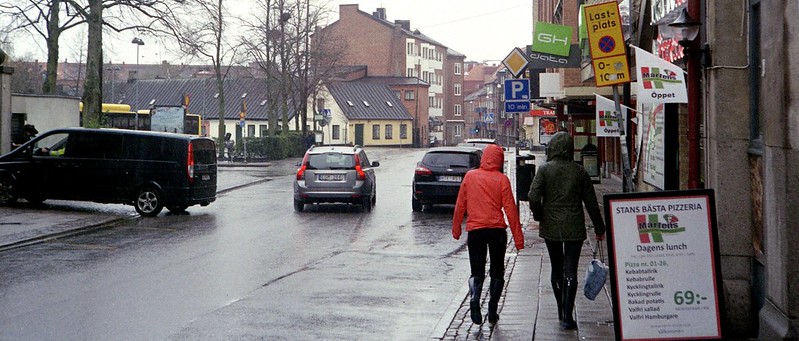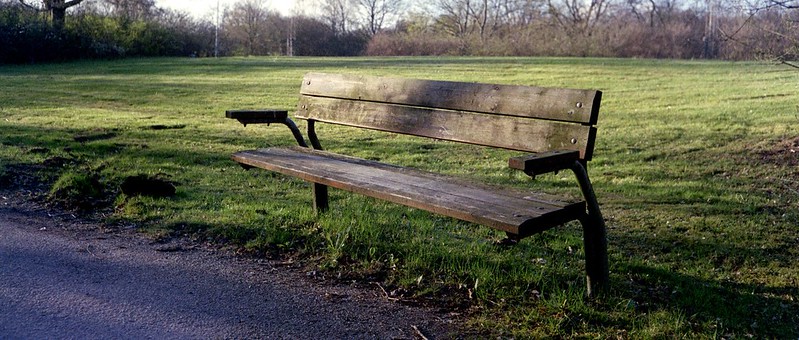ForestCap
Well-known
 photo 4 (1) by X. Yang, 於 Flickr
photo 4 (1) by X. Yang, 於 FlickrI won a "Canon VL2" on eBay, but it turned out to be a L2 with metal curtains. I was too careless to notice the self-timer and flash sync selector differences. I have no idea if the curtains were replaced after factory or made so as is.
After cleaning under the top plate, doing some shutter accuracy and focusing tests/calibrations... (you know, all the necessary things), I became a happy owner of this solid and practical camera. So I decided to write down my observation and thinking of this camera. Some of the points in this writing might have been post online by others while some might not.
Viewfinder/Rangefinder:
As one of the biggest features of Canon V and VI series rangefinder cameras (except Canon P), the viewfinder has three selectable modes/field of view: "50", "35" and "RF"(for critical focusing). You can turn a cogwheel - namely "Viewfinder Selector" - near the eyepiece to select the one you want manually.
The magnification of viewfinder is x0.72 for 50mm, x0.4 for 35mm and x1.4 for RF. The view of RF mode is oval-shaped, so you can't really use it as a 135mm FOV for framing as some online posts suggested.
Unlike Canon VI series cameras, none of the viewfinder modes on L2 have bright frame-line nor parallel correction. Talking about actual using of viewfinders, I actually prefer good "peephole" type to bright-line type with too many cuts/gaps in between, and I must say L2's "peephole" is really good. I'm an eye-glass wearer and prefer shooting with glasses on. The eye point of L2's viewfinder is long enough for me too see the whole frame, especially the 35mm, thanks to the low magnification. I don't mind soft edges of the frame and I will definitely use this camera more due to the nice viewfinder. Currently it has the best peephole type viewfinder I've used. The next to best I've seen is the one on Zorki-6.
And, don't worry about scratching your eye-glass with the viewfinder selector cogwheel, which you might have read somewhere online: the viewfinder eyepiece protrudes a bit, so your glasses are very unlikely to touch the cogwheel.
The brightness, or maybe calling it darkness makes more sense, of the viewfinder is not bad at all, only around -2.5EV at 50mm mode, similar to Zorki-4 and 6, a bit worse than the bright and more advanced Canon 7 (-1.5EV), better than FED-2 (-4EV) and KIEV(-3.5EV). I'd say It's good enough for casual indoor shooting.
The rangefinder patch has a round shape with a gold tone. The visibility of the patch is not impressive (I'd call the one on Kiev-4 impressive, but maybe it's partially due to the darker viewfinder), fortunately the size of the patch is big, so it's still fairly easy to focus. Canon's online camera museum says the gold mirror was changed into silver in the Canon VI series in order to increase patch visibility , however I can't compare since I don't own any VI series cameras.
Shutter:
The shutter works well when it arrives, which corresponds to the praise from online folklore. I have no idea when was this camera last serviced or used for actual shooting, but judging from the happy fungus clusters inside the viewfinder I dare say a couple of decades. The shutter was really built to last and relatively maintenance-free, as Canon's manual "bragged". I like the metal shutter curtains since it's safer, and it's one of the reasons why I bought this camera.
The shutter sound is noisier than most of the LTM cameras I own, namely my Zorki-4, 6, FED-2, and its grandson Canon-7, and on a par with my Zorki-1. All those cameras were home-adjusted and some of them have minimum shutter tension. Test shots turned out fine with no uneven exposure, so I just didn't bother to change anything.
Flash sync:
The L2 has FP(Focal Plane Bulb) sync only.
Lens compatibility:
For LTM cameras, I use FSU lenses only (call me cheap). I did the ground glass/tape test and it showed that my Jupiter-3, which focuses well on my Zorkis, focused well on the Canon L2 too, and then the test shots double-secured it. I calibrated the J-3 to have spot on focus at f/2 on my Zorki-6, and it behaves the same when mounted on the L2. My un-calibrated-for-nothing black Jupiter-8 also focuses well at f/2, at min distance. You know, the "non-Leica standard" thingy haunted me a lot when I was a complete newbie.
Another good news is my 1970s black Jupiter-12 mounts well on L2 and can be used normally without problem. With the J-3 and J-12 working, I'm good to go. I would occasionally use the J-8 and a rigid glossy black finish Industar-50 (when contrast matters) on the L2. Or someday I might buy some Canon lenses for it.
Size/Form factor:
The dimension is 140x75x31mm, w/o protruding parts. Not too small, not too large, though I won't carry out any attempts to use it as a pocket-able camera. One big plus is it stays streamlined with 35mm lens mounted, thanks to the smart design of multi-fov viewfinder.
Other things:
A small surprise to me was the frame counter COUNTS DOWN from 36 to 0 on the L2. After reading the manual I knew it's designed to be like this.
There is a film transport indicator on the top plate (as on all Canon V, VI and 7 series cameras), so when rewinding I don't need to stick the camera to my ear to hear the "pop" of film leader jumping out of take-up spool (I'm too cheap to buy a film leader retriever). A very handy feature for home film developing.
The camera hangs awkwardly when using both strap lugs. So I screw on another strap eyelet to the tripod socket and skip the lug on the left side of the camera.
That's most of it. With one test roll burnt, I've already started to like the camera. Function-wise, the L2 is equipped with all I need. It has what I missed when shooting with Canon-7, the elegance from a refined body, which was dropped for the sake of the projected frame-lines and the light meter.
I picked some not so boring shots from the test roll to post there, and skipped all the "focused on a bottle cap at 1m" pictures. All were shot on Fujicolor C200 and developed in Tetenal C41. Thanks for reading!
Jupiter-8
 Scan-160630-0006
Scan-160630-0006 Jupiter-3
 Pink Lighnting by X. Yang, 於 Flickr
Pink Lighnting by X. Yang, 於 FlickrJupiter-12
 Tomato Man by X. Yang, 於 Flickr
Tomato Man by X. Yang, 於 FlickrJupiter-3
 Rainy Day by X. Yang, 於 Flickr
Rainy Day by X. Yang, 於 FlickrJupiter-12
Jupiter-12
 Bench by X. Yang, 於 Flickr
Bench by X. Yang, 於 FlickrJupiter-12
 Retired Holmes by X. Yang, 於 Flickr
Retired Holmes by X. Yang, 於 Flickr

